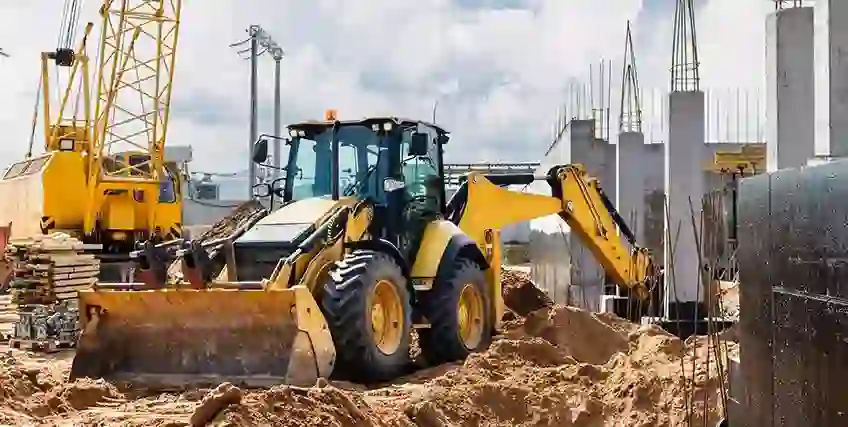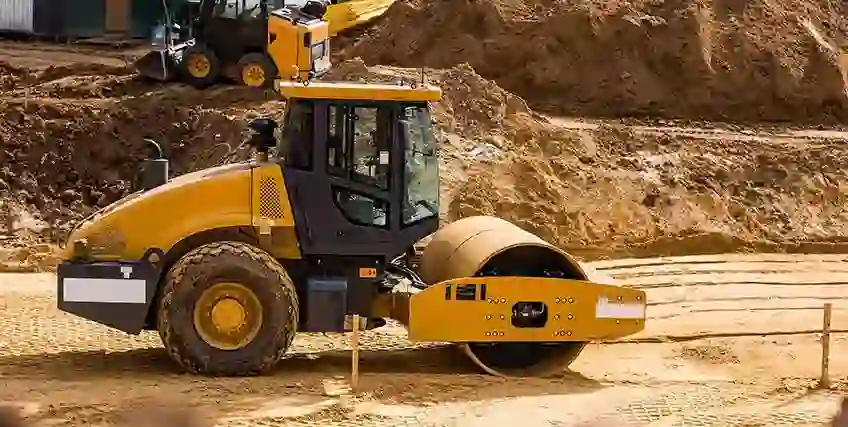Heavy Equipment Financing and Leasing for Construction Companies
May 12, 2025 | Last Updated on: May 12, 2025

Article Summary:
- Heavy equipment financing and leasing can help construction companies get the equipment they need.
- When looking at equipment financing and leasing, the former offers ownership while the latter typically doesn’t.
- Monthly payments and total costs differ.
Heavy Equipment Financing vs. Leasing: What’s Better for Construction Firms
Construction spending is on the rise. As of February 2025, construction spending estimates hit a seasonally adjusted annual rate of $2,195.8 billion, increasing 2.9% year over year, according to Census data. Additionally, the construction sector had a slight increase in employment in March 2025 compared to a few months prior, based on Bureau of Labor Statistics data.
If you’re part of a construction company, you might have multiple projects lined up and ready to go. Depending on the type of construction, you might need new equipment to get started or ensure you have the latest models to get your project off the ground. Purchasing heavy equipment such as cranes, bulldozers, excavators, or blast drill holes is a major investment. For example, buying a small bulldozer can bulldoze your budget and set you back more than six figures.
Paying upfront for heavy equipment may not be an option or if it is, it could seriously affect your cash flow. Instead, you can look into heavy equipment financing and leasing. Here we cover more about these unique financing solutions and how they work and can help with your business needs.
What is Heavy Equipment Financing?
Heavy equipment financing typically refers to taking out a specific type of loan to purchase equipment. When you get an equipment loan, you generally get lump sum funding to make the purchase. While all lenders will have certain underwriting criteria you must meet to qualify, equipment loans may have more favorable approval odds as the equipment itself acts as collateral on what you borrow.
That can make it easier to qualify for financing. However, it also means that if for some reason you default on the equipment loan, the lender has the legal right to seize the piece of equipment.
Equipment financing can offer you the cash you need to make an investment in your business and get up-to-date heavy equipment. However, as a borrower you may still need to put up a 10% to 20% down payment.
When comparing equipment financing and leasing, you’ll typically have steeper monthly payments with an equipment loan. But the main advantage you get is ownership. Once the equipment loan is paid off, you have 100% ownership over what you bought.
What is Heavy Equipment Leasing?
Heavy equipment leasing refers to an arrangement between a lessor (owner) and a lessee (renter). Through an equipment lease, you can access different types of equipment with more flexibility and less commitment.
Typically, you’ll have lower monthly payments with an equipment lease. The drawback is that you may pay more throughout your repayment term than you would with an equipment loan. Plus, you won’t own the equipment once your lease is up. However, there are different leasing arrangements. At the end of the lease, you may:
- Have a purchase option, which allows for equipment buyout.
- Renew your lease for another term.
- Return your equipment.
Leasing equipment provides maximum flexibility, which can be attractive if you’re unsure about committing to such a large expense. Lease agreements could either be:
- A capital lease: This is a type of equipment lease to own arrangement. So, once you hit the end of your lease term, you have the opportunity to purchase the equipment. Be aware that you may be on the hook for insurance and taxes. Plus, you may need to make a balloon payment to cover the rest.
- An operating lease: This type of equipment lease is more of a rental arrangement where you pay to access the equipment for a set term. You may not have to pay additional fees. But you also may not be able to buy the equipment at the end of the lease.
On either type of lease, the equipment goes on your balance sheet as an asset and a liability. Each option may come with different tax benefits as well. A capital lease allows you to claim interest and depreciation on the equipment. An operating lease allows you to deduct the payment as a business expense. Talk to an accounting professional for specifics.
Equipment Financing and Leasing Pros and Cons
Business owners in the construction field need to stay competitive and have the right tools to do the job. That can mean investing in heavy equipment purchases. Equipment financing and leasing are two financing solutions that can help you but work very differently. Before deciding on an option, compare the pros and cons.
Equipment financing pros:
- Complete ownership
- May have some tax benefits
- Lump sum funding for your equipment needs
Equipment financing cons:
- Typically requires a down payment
- Higher monthly payments
- As technology improves, equipment could become obsolete
Equipment leasing pros:
- Maximum flexibility with renewable lease or option to return the equipment
- Lower monthly payments
- No down payment
Equipment leasing cons:
- No equity or ownership
- May pay more in total
- May have early termination fees
Both equipment financing and leasing have benefits and drawbacks to consider. Each option can help improve your cash flow and secure the necessary heavy equipment needed in construction.
The major differences are in monthly payments, ownership, and flexibility. Financing makes sense if you intend to use the equipment frequently and have a long-term plan. Leasing can make sense if you’re looking for lower payments to get started and want to maintain flexibility.
Consider using online calculators to determine total costs and review multiple options. Don’t just look at one equipment financing company or leasing company. Spending extra time comparing heavy equipment financing and leasing and looking at various companies can help you make an informed decision.
Having all the information can ensure you’re making the right choice based on your business budget, needs, and goals. Additionally, create a plan for repayment and budget in the extra costs so you don’t put your business or the equipment you buy at risk.
How to Choose the Right Funding Option
Heavy equipment financing and leasing provide different options to help you get access to what you need without paying a large sum of money upfront. Each option provides unique benefits and drawbacks. To help you choose the right funding option, here are some things to consider:
- Cash flow: Look at how the monthly payments on either equipment financing or leasing will affect your cash flow. An equipment loan can come at a higher price tag, and you want to make sure you can afford the payments.
- Flexibility: An equipment lease can provide more flexibility and options. You can decide to either renew the lease and continue using the equipment or give it back and end the agreement. An equipment loan is more of a commitment, and you run the risk of having the items you buy become out of date during your repayment term.
- Upfront costs: A heavy equipment loan will typically require you to put a down payment before getting the funds. In most cases, an equipment lease doesn’t require a down payment. But that doesn’t mean a lease doesn’t have any upfront costs. Typically, you need to put down a security deposit with an equipment lease. This provides the company leasing the equipment with more protection in the event you don’t return the equipment or it is damaged.
- Equipment usage: Evaluating how you’ll use the equipment can help you decide whether to pursue heavy equipment financing or leasing. If you are only using it for a one-off project or something that’s short-term, a lease may be more beneficial. If the equipment will be used for various construction projects for years to come, getting a loan can make more sense. Once the equipment is yours, you can continue to use it or sell it.
Final Thoughts on Equipment Financing and Leasing
Trying to come up with the funds to purchase heavy equipment on your own may not be feasible. Two options to look into are equipment financing and leasing. Before you decide which option is best for your small business, do your research. Look at the various providers that offer equipment financing. You can check out business banking options, credit unions, and online and alternative lenders. For leasing, check out multiple heavy equipment leasing companies.
See if you meet the eligibility requirements, such as minimum credit score and time in business. Review potential interest rates and your monthly payments and how heavy equipment financing and leasing can help you in the short term and the long term.
FAQs about Equipment Financing and Leasing
If you’re weighing your options and looking into heavy equipment and leasing, here is additional information with answers to frequently asked questions.
How Does Leasing Heavy Equipment Work?
Leasing heavy equipment allows you to make monthly payments in exchange for access to the heavy equipment you need. It’s generally more of a rental situation, though there are equipment lease to own situations. Each financial lease for machines or equipment is different.
What Should You Look for in Heavy Equipment Leasing Companies?
Look for companies that specialize in heavy equipment leases and cater to the construction business. Make sure the company offers the equipment you need and that you meet the requirements such as credit approval, business history, and revenue. Compare both equipment financing and leasing.
Which Is Better Equipment Financing or Leasing?
When looking at equipment financing and leasing, the best option depends on your immediate and long-term needs. If you value ownership, equipment financing is a better option. But if you value flexibility and no commitment, equipment leasing is a good alternative.
What Are Financing Options for Heavy Equipment in Construction?
To finance heavy equipment, you can look into term business loans or specific heavy equipment loans which use the items you buy as collateral. Banks and other financial services providers may offer this type of financing. You can also look into the Small Business Administration 504 loan.
How Long Do Equipment Lease Terms Last?
Equipment lease terms depend on the provider but typically can be several years, up to 10 years. Be sure to look at the fine print and understand your options at the end of your lease with commercial equipment leasing companies.




